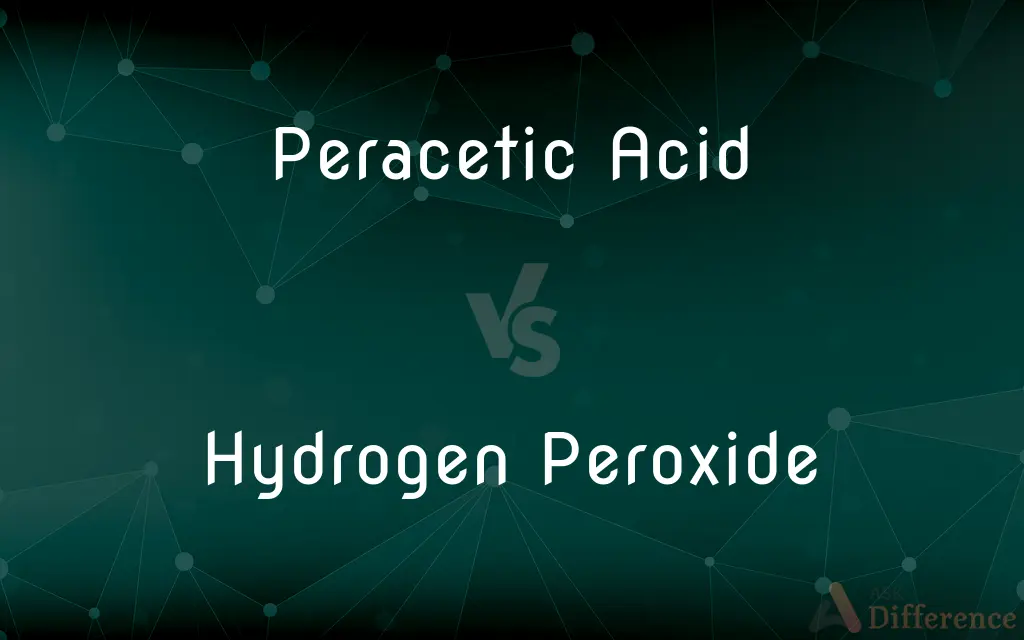Peracetic Acid vs. Hydrogen Peroxide — What's the Difference?
By Tayyaba Rehman — Published on November 23, 2023
Peracetic acid is a potent disinfectant composed of acetic acid and hydrogen peroxide. Hydrogen peroxide is a chemical compound (H₂O₂) used for disinfection, bleaching, and wound cleaning.

Difference Between Peracetic Acid and Hydrogen Peroxide
Table of Contents
ADVERTISEMENT
Key Differences
Peracetic acid and hydrogen peroxide are both powerful oxidizing agents. While peracetic acid is the product of the reaction between acetic acid and hydrogen peroxide, hydrogen peroxide stands alone as its molecule, H₂O₂.
In the realm of disinfectants, peracetic acid stands out for its broad spectrum of antimicrobial activity and its efficacy even at low concentrations. Hydrogen peroxide, on the other hand, is widely recognized for its disinfecting and bleaching properties, as well as its role in wound care.
Stability distinguishes these two chemicals. While peracetic acid can decompose into non-toxic components, hydrogen peroxide breaks down into water and oxygen when exposed to light, making its storage in dark containers imperative.
Both chemicals have found applications in various industries. Peracetic acid is frequently used in the food and beverage sector as a sterilant, while hydrogen peroxide's uses range from personal care products to industrial processes.
To summarize, while peracetic acid and hydrogen peroxide share some similarities as oxidizing agents and disinfectants, they are distinct in their chemical compositions, stability, and range of applications.
ADVERTISEMENT
Comparison Chart
Chemical Composition
Combination of acetic acid and hydrogen peroxide
H₂O₂
Primary Uses
Disinfectant, sterilant for food industry
Disinfection, bleaching, wound care
Decomposition Products
Non-toxic components
Water and oxygen
Stability
Decomposes easily
Stable but decomposes in light
Toxicity
Potent and should be handled with care
Can be irritant at high concentrations
Compare with Definitions
Peracetic Acid
A potent antimicrobial agent.
Due to its antimicrobial properties, peracetic acid is popular in the food industry.
Hydrogen Peroxide
An oxidizing agent used for disinfection.
Many turn to hydrogen peroxide for wound disinfection due to its antimicrobial action.
Peracetic Acid
A compound resulting from acetic acid and hydrogen peroxide.
The synthesis of peracetic acid involves the combination of acetic acid with hydrogen peroxide.
Hydrogen Peroxide
A molecule that decomposes in the presence of light.
Exposure to light causes hydrogen peroxide to break down into water and oxygen.
Peracetic Acid
A strong oxidizing agent.
Peracetic acid's oxidizing power makes it an effective disinfectant.
Hydrogen Peroxide
A chemical compound with the formula H₂O₂.
Hydrogen peroxide is often kept in brown bottles to prevent decomposition.
Peracetic Acid
A chemical with broad-spectrum activity.
Peracetic acid can kill a wide range of pathogens in various environments.
Hydrogen Peroxide
A common household bleaching agent.
Hydrogen peroxide can help remove stains from white clothing.
Peracetic Acid
A substance used for sterilization.
Medical instruments are sometimes sterilized using peracetic acid.
Hydrogen Peroxide
A component in various personal care products.
Some toothpastes contain hydrogen peroxide for teeth whitening.
Common Curiosities
Can peracetic acid be used for disinfection?
Yes, peracetic acid is a potent disinfectant with broad-spectrum antimicrobial activity.
How is hydrogen peroxide used medically?
Hydrogen peroxide is often used for wound cleaning and disinfection.
Is peracetic acid harmful?
Peracetic acid is potent and should be handled with care, as it can be corrosive and harmful if mishandled.
In which industries is peracetic acid commonly used?
It's popular in the food and beverage industry, especially for sterilization purposes.
Does hydrogen peroxide bleach fabrics?
Yes, hydrogen peroxide is used as a bleaching agent and can lighten fabrics.
Is it safe to mix hydrogen peroxide with other household chemicals?
No, it can react with other chemicals, potentially producing harmful compounds or gases.
What concentration of hydrogen peroxide is safe for skin contact?
Low concentrations (around 3%) are typically used for wound cleaning, but higher concentrations can be irritant.
Why is hydrogen peroxide stored in dark bottles?
To prevent its decomposition, as it breaks down into water and oxygen when exposed to light.
Can hydrogen peroxide be used orally?
In diluted form, it's used in mouthwashes and toothpastes, but swallowing concentrated solutions is harmful.
What happens when peracetic acid decomposes?
It decomposes into non-toxic components like water, oxygen, and acetic acid.
How effective is peracetic acid against microbes?
Peracetic acid is very effective and can inactivate a wide range of pathogens.
What is peracetic acid made of?
Peracetic acid is formed from the reaction of acetic acid with hydrogen peroxide.
Can peracetic acid be used in water treatment?
Yes, it's used in some water treatment processes due to its disinfection capabilities.
How should one handle peracetic acid safely?
Using gloves, eye protection, and ensuring good ventilation are crucial when handling peracetic acid.
Does hydrogen peroxide have a shelf life?
Yes, over time and with exposure to light, it will decompose and lose its potency.
Share Your Discovery

Previous Comparison
Deject vs. Reject
Next Comparison
Best Regards vs. Yours FaithfullyAuthor Spotlight
Written by
Tayyaba RehmanTayyaba Rehman is a distinguished writer, currently serving as a primary contributor to askdifference.com. As a researcher in semantics and etymology, Tayyaba's passion for the complexity of languages and their distinctions has found a perfect home on the platform. Tayyaba delves into the intricacies of language, distinguishing between commonly confused words and phrases, thereby providing clarity for readers worldwide.
















































